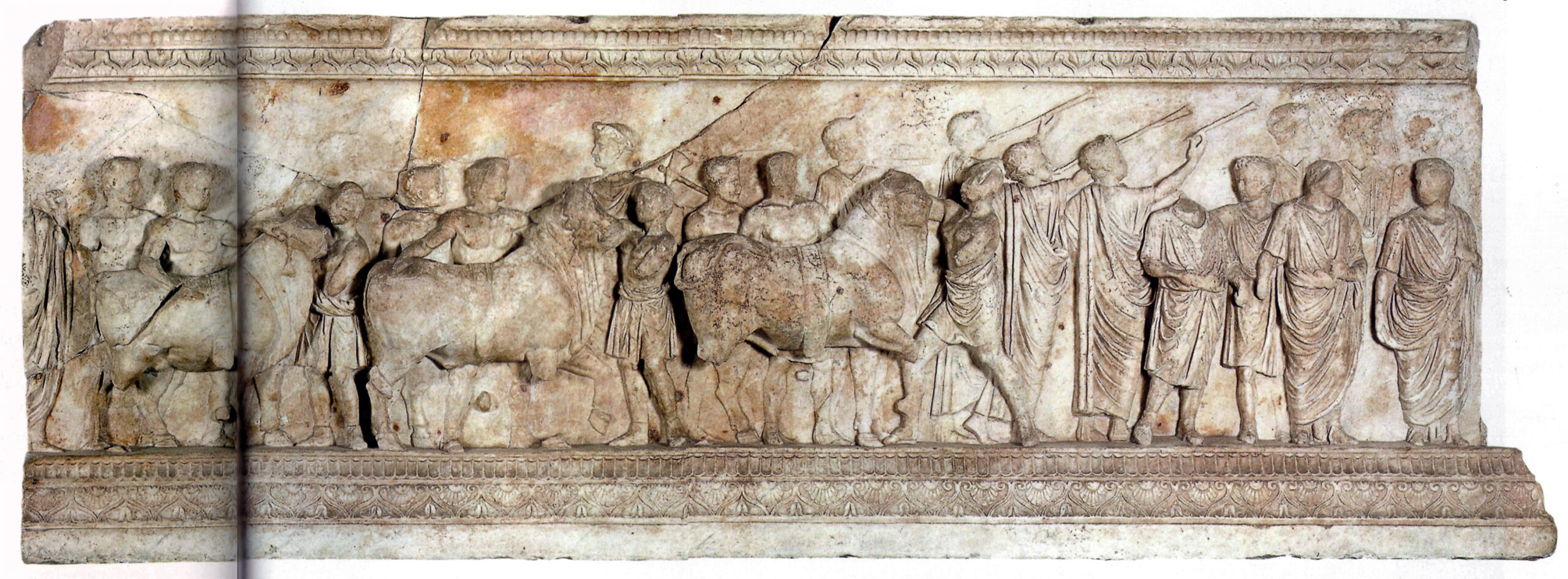Honorary decree of the boule and demos of Priene for Moschion Kydimou
| TITLE: |
| Honorary decree of the boule and demos of Priene for Moschion Kydimou |
| DATE: |
| 129/100 BC |
| TEXT: |
| I.Pri. 108 = SEG 39 1262 [Holleaux, BCH 31, 1907. 385-386 (ll. 28, 30, 39-40, 54, 56, 61, 171, 222, 372); **Wilhelm, WS 29, 1907, 19-20 (ll. 59, 216, 377); **Graindor, Mus. belge 11, 1907, 127 (l. 45); **Wilhelm, NB VI 51-2 (ll. 104-5); **Robert, RPh 53, 1927, 100, note 1 (l. 74); SEG 4, 491; **Koerner, Philologus 108, 1964, 140-2 (l. 258); Migeotte, L’emprunt public no. 94] HILLER VON GAERTRINGEN (1906): Inschriften Von Priene, Georg Reimer, Berlin |
| EDITIONS/TRANSLATIONS: |
| I.Pri. 108 (English) CARBONNEAU, I (1988): “L’évergétisme à Priène à la fin de l’époque hellénistique”, PhD Dissertation, Université Laval, pp.45-52 (French) |
| KEYWORDS: |
| Word used to mean procession: |
| προεπ̣[όμπευσεν] (l. 281, vb. προπομπεύω, “go before in a procession”) |
| Word used to mean the cult images: |
| εἰκόνι χρυσῆι (l. 5, 317-318) |
| Gods or other entities named: |
| Olympian Zeus (Διὸς τοῦ Ὀλυμπίου, l. 254); Olympian [Zeus] 260 and Hera and Athena Polias and Pan Arogos ([Διὶ τ]ῶι Ὀλυμπίωι καὶ τῆι Ἥραι καὶ τῆι Ἀθηνᾶι τῆι Πολιάδι καὶ [τῶι Πα]νὶ τῶι Ἀρωγῷ, l. 26-261) |
| Description of the cult images: |
| Procession’s route: |
| In the streets of Priene |
| Frequency with which the procession takes place: |
| Performers: |
| Moschion, while he was alive, as stephanophoros or “city president” of Priene (Grainger 1997, p. 473), i.e. “garland-wearer”, the eponymous magistrate of some Hellenistic cities such as Priene, Miletus or Magnesia; the title could also be given to high-ranking priests. Througout his time as stephanophoros Moschion led a procession in the festival of Panathenaia with a cow worthy of Athena (l. 281-282, προεπ̣[όμπευσεν δὲ καὶ ἐν τῆι τῶν Πανα]θηναίων ἑορτῆι βοῒ τῆς Ἀθηνᾶ[ς ἀξίαι) When Moschion died, the funeral procession was followed by the paidonomoi (officials in Greek cities, responsible for the training of boys who were younger than ephebes) with the boys and the gymnasiarch bringing the ephebes and the youths and the generals with the other citizens (l. 366-370, συνακολουθῆσαι δὲ] [τῆι ἐκφορᾶι τού]ς [τε π]αι[δο]νόμους [μετὰ τῶν] παίδων [καὶ] τὸγ γυμνασίαρχον ἔχο[ντα τούς] τε ἐφήβους καὶ τοὺς νέους καὶ τοὺ[ς στρατηγοὺς] μετὰ τῶν ἄλλων πολιτῶν) |
| References to the public attending the procession: |
| The procession was so splendid that Moschion received the approbation from the foreigners who were staying in the city during the Panathenaia (l. 85-87, ἐπιφανῆι τὴν πρὸς π[άντας εὔνοιαν ἀποδειξάμενος,] ὥστε καὶ παρὰ τοῖς ἐπιδεδ̣[ημηκόσι τῶν ξένων ἀποδοχῆς τῆς] μεγίστης τετευχένα) |
| Rites related to the procession: |
| Allusions to conduct or forms of reverence: |
| Moschion gave a demonstration of his absolute devoutness towards the gods by leading the procession (l. 281-282, προεπ̣[όμπευσεν δὲ καὶ ἐν τῆι τῶν Πανα]θηναίων ἑορτῆι βοῒ τῆς Ἀθηνᾶ[ς ἀξίαι) |
| Other remarkable elements: |
| By the time of this decree, a benefactor was often distinguished more by his regular handouts from his personal wealth than by his exploits in the service of the state; this long inscription contains one of the most detailed surviving accounts of the career of a local benefactor in Hellenistic times, Moschion’s career lasted well over twenty years, from the reign of Demetrios I of Syria (161-150 B.C.) up until the Roman settlement of Asia Minor in 129 B.C. Cf. Horster and Klöckner (2013, p. 133): “[Moschion] was not being honoured exclusivley in his capacity as a priestly officer, but also as an important benefactor of the city”. |
| BIBLIOGRAPHY: |
BÖMMER (1952), RE: s.v. Pompa. Herrscher, Vol. XXI.2, p. 1972, n.337 ECKARD, A. (2012): “Female patronage and economic prominence at Hellenistic Priene”, All Theses and Dissertations (ETDs). 735, p. 13 GRAINGER, J. D. (1997): A Seleukid Prosopography and Gazetteer, Brill, Leiden, p. 473 HORSTER, M.; Klöckner, A. (eds.) (2013): Cities and priests cult personnel in Asia Minor and theAegean Islands, De Gruyter, Berlin, p. 133, 166 SERES, D. (2017): “Dynamics of public memory in Hellenistic Priene: a case study”. In: Bajnok, Dániel (ed.): Alia miscellanea antiquitatum. Proceedings of the Second Croatian–Hungarian PhD Conference on Ancient History and Archaeology. Budapest-Debrecen, pp. 189–200 PLEKET, H.W., “SEG 39-1262. Priene. Honorary decree for Moschion, after 129 B.C.”, in: Supplementum Epigraphicum Graecum, Current editors: A. T. E. N. Chaniotis Corsten Stavrianopolou Papazarkadas. Consulted online on 28 October 2021 |
